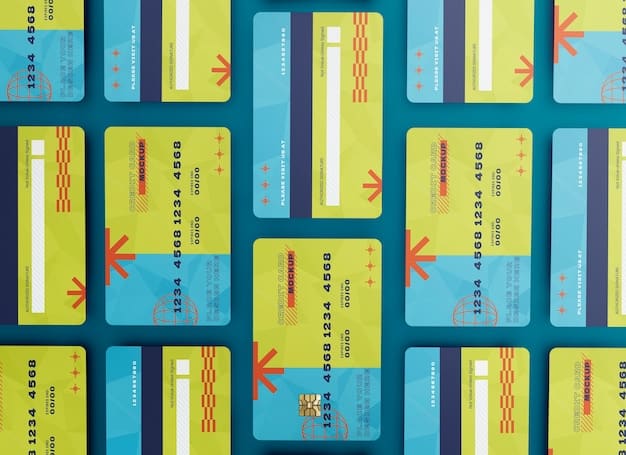Travel Hacking Loyalty Programs: Earn Free Trips Faster

Anúncios
Mastering loyalty programs allows savvy travelers to accumulate rewards points and miles at an accelerated pace, significantly reducing the cost of flights, accommodations, and other travel expenses through strategic earning and redemption methods.
Anúncios
Embarking on a journey to explore the world without breaking the bank might seem like a distant dream, yet it’s entirely achievable through strategic utilization of loyalty programs. This comprehensive guide, “The Ultimate Guide to Travel Hacking Loyalty Programs: Earn Free Trips Faster“, will demystify the art of leveraging these systems to transform your travel aspirations into reality. We’ll delve into proven techniques, common pitfalls to avoid, and cutting-edge strategies to maximize your rewards, ensuring your next adventure is closer and more affordable than you imagine.
understanding loyalty programs: the foundation of travel hacking
Loyalty programs are designed by airlines, hotels, and credit card companies to reward customer loyalty, typically through points or miles that can be redeemed for travel benefits. Understanding their fundamental mechanics is the first step towards effectively “travel hacking” – a term for using these programs strategically to minimize travel costs.
Anúncios
At its core, travel hacking involves maximizing point accumulation and optimizing redemption. This isn’t just about flying frequently or staying at premium hotels, but rather about making smart financial decisions that concurrently build your travel currency. From signing up bonuses to everyday spending, every transaction can be an opportunity to earn more.
types of loyalty programs
There are generally three main categories of loyalty programs that travel hackers utilize:
- Airline Loyalty Programs: Earn miles through flights, co-branded credit cards, and partnerships. These miles can then be used for free flights, upgrades, or even car rentals.
- Hotel Loyalty Programs: Accumulate points for hotel stays, often with bonus points for elite status or co-branded credit card spending. Points are redeemable for free nights, room upgrades, or experiences.
- Credit Card Loyalty Programs: These are often the most flexible, allowing you to earn points that can be transferred to various airline and hotel partners, or redeemed directly for travel purchases.
Each program has its own unique rules for earning and redeeming, making it crucial to examine their terms closely. The value of a point or mile can vary significantly across programs, so understanding the true worth of your rewards is key to making informed decisions.
The beauty of these programs lies in their interconnectedness. Often, points earned with a credit card can be transferred to airline or hotel programs, offering a powerful synergy that amplifies your earning potential. Knowing which transfers offer the best value is a cornerstone of advanced travel hacking strategies.
Furthermore, many programs offer elite status tiers, which provide additional benefits such as bonus points, complimentary upgrades, lounge access, and expedited services. Achieving elite status, either through actual travel or through credit card benefits, can significantly enhance your travel experience and accelerate your reward accumulation.
mastering credit card sign-up bonuses for rapid point accumulation
Credit card sign-up bonuses are arguably the most potent tool in a travel hacker’s arsenal for rapid point accumulation. These bonuses, often tens of thousands of points or miles, are offered as an incentive for new cardholders to meet a specified spending requirement within a certain timeframe.

The strategy here is to identify cards with generous bonuses that align with your travel goals and spending habits. It’s not about reckless spending, but rather about channeling your existing expenses through new credit cards to unlock these valuable rewards without incurring unnecessary debt.
strategizing your applications
Applying for credit cards strategically involves understanding your credit score, the issuer’s application rules (like Chase’s 5/24 rule), and the timing of your applications. Too many applications in a short period can negatively impact your credit score, so a measured approach is essential.
- Research High-Value Bonuses: Prioritize cards offering substantial bonus points or miles that can be transferred to your preferred airline or hotel programs.
- Meet Spending Requirements Thoughtfully: Plan out how you will meet the minimum spending. Consider upcoming large purchases, pre-paying bills, or simply using the card for your everyday expenses.
- Understand Issuer Rules: Be aware of specific rules, such as how often you can receive a sign-up bonus from the same issuer, to avoid wasting credit inquiries.
Many credit card companies impose restrictions on how often you can earn a sign-up bonus, or how many new cards you can open within a given period. Familiarizing yourself with these rules is crucial to optimize your application strategy and avoid being denied or missing out on a bonus.
Beyond the initial bonus, consider the ongoing earning potential of a card. Some cards offer elevated earning rates on specific spending categories, such as dining, travel, or groceries. Integrating these cards into your daily spending routine can provide a steady stream of points long after the sign-up bonus has been earned.
It’s also important to track your spending and payment due dates diligently. Missing a payment not only incurs fees but can also damage your credit score, undermining the very foundation of successful travel hacking. Automation of payments and regular monitoring of accounts are highly recommended.
optimizing everyday spending: turning expenses into free travel
While sign-up bonuses offer a quick boost, optimizing your everyday spending is the sustainable engine of travel hacking. Every dollar spent on your credit card can be
converted into points or miles, steadily building your rewards balance. The key lies in strategic card usage and leveraging bonus categories.
This process is about being mindful of your expenditures and aligning them with the earning structures of your credit cards. It’s not about spending more, but spending smarter. Identifying which card offers the best return for specific types of purchases becomes a habit.
category bonuses and multiplier earning
Many credit cards offer bonus categories where you earn accelerated points per dollar spent. These often include:
- Dining and Groceries: Common bonus categories for cards aimed at everyday consumers.
- Travel and Entertainment: Popular for travel-focused cards.
- Gas Stations and Utilities: Less common, but valuable for consistent expenses.
By using the right card for the right purchase, you can significantly increase your earning rate. For example, if one card offers 3x points on dining and another offers 2x points on groceries, you’d use each for its respective category to maximize earnings.
Beyond standard bonus categories, some cards offer rotating bonus categories that change every quarter. Enrolling in these bonuses typically requires a quick activation, and they can provide excellent opportunities to earn 5x points or more on specific types of purchases for a limited time.
Another often overlooked strategy is utilizing shopping portals. These online platforms, often affiliated with airlines or credit card programs, offer bonus points for purchases made through their links with participating retailers. This can be an easy way to earn extra points on online shopping you were already planning to do.
Consider also the synergy between primary and supplementary cards. Some premium travel cards may offer high earning rates but come with an annual fee. Pairing them with no-annual-fee cards that offer bonus categories for everyday spending can create a balanced portfolio that maximizes earnings across all your expenditures.
navigating redemption strategies: maximizing point value
Earning points is only half the battle; knowing how to redeem them effectively is where the true value of travel hacking is realized. Not all redemptions are created equal, and understanding the nuances can mean the difference between a minor discount and a practically free luxury trip.
The goal is to aim for redemptions that yield a high “cents per point” (CPP) value. This means getting more value out of each point than if you were to simply convert it into cash or use it for non-travel related redemptions.
sweet spots and transfer partners
One of the most powerful redemption strategies involves transferring flexible points (like Chase Ultimate Rewards or Amex Membership Rewards) to airline or hotel loyalty partners. This is where “sweet spots” often emerge:
- Business or First Class Flights: Often offer disproportionately high value per point compared to economy.
- Luxury Hotel Stays: Points can sometimes provide exceptional value for high-end properties, especially during off-peak times.
- Strategic Airline Alliances: Transferring points to an airline within an alliance (e.g., Star Alliance, SkyTeam, Oneworld) can unlock award flights across numerous partner airlines, offering more destination options.
Always compare the cash price of a flight or hotel stay with the points required to book it. A quick calculation of “cash price / points required” will give you the CPP value. Aim for redemptions that offer at least 1.5-2 cents per point, though much higher values are often achievable.
Dynamic pricing for award travel is becoming more prevalent, meaning the number of points required for a flight or hotel stay can fluctuate based on demand, seasonality, and other factors. Being flexible with your travel dates and destinations can often lead to significantly better redemption values.
Another aspect of redemption is understanding stopovers and open-jaw tickets. Some airline programs allow you to add extra destinations or return from a different city without significantly increasing the points required, effectively offering multiple trips for the price of one award ticket.

Consider the value of companion passes or free night certificates that come with certain credit cards. These benefits can often be extremely valuable, providing a significant boost to your travel savings, especially when combined with strategic point redemptions.
avoiding common pitfalls and maintaining financial health
While travel hacking offers incredible opportunities, it’s crucial to approach it with discipline and financial prudence. Careless mistakes can negate any benefits earned and potentially damage your credit score, making future financial endeavors more challenging.
The primary rule of travel hacking is never to spend money you wouldn’t otherwise spend. The allure of bonus points should not lead to unnecessary purchases or carrying a balance on your credit cards, as interest charges will quickly outweigh any rewards earned.
credit score management and debt avoidance
Your credit score is your most valuable asset in travel hacking. Here are key considerations:
- Pay Bills on Time and in Full: This is non-negotiable. Interest charges quickly erode the value of any points earned.
- Monitor Your Credit Score: Keep an eye on your credit report for any discrepancies and understand how new applications impact your score.
- Don’t Close Accounts Hastily: Older credit accounts contribute positively to your credit history’s length. If a card has an annual fee, consider downgrading to a no-fee version instead of closing it, if available.
The number of new credit accounts and the average age of your accounts are factors in your credit score. Opening many cards in a short span can lower your score temporarily, but responsible management will see it rebound.
Be aware of minimum spending requirements. Some large bonuses require significant spending in a short period. Only apply for cards when you are confident you can meet these requirements through your regular monthly expenses or planned large purchases.
Additionally, beware of the “churning” trap – applying for and canceling many cards just for the bonus. While it can be effective, it carries risks to your credit score and can make you ineligible for future bonuses from certain issuers if done excessively or without proper consideration.
Annual fees are another important consideration. While many high-bonus cards come with annual fees, these are often offset by the value of the sign-up bonus and ongoing benefits. Evaluate if the benefits truly outweigh the fee before committing to a card.
advanced travel hacking techniques for seasoned explorers
Once you’ve mastered the basics of earning and redeeming, advanced travel hacking techniques can unlock even greater value and new travel possibilities. These strategies often involve a deeper understanding of loyalty program intricacies and seeking out niche opportunities.
This level of travel hacking moves beyond simple credit card bonuses to more complex methods of point procurement and utilization, often requiring more flexibility and research.
manufactured spending and portal stacking
While caution is advised and rules frequently change, some advanced techniques include:
- Manufactured Spending (MS): This involves creating spending to meet minimum requirements or earn points without actual consumption of goods or services. Examples might include purchasing gift cards with a credit card and then converting them back to cash (though many programs have tightened rules on this).
- Portal Stacking: Combining credit card bonus categories with online shopping portals for multiple layers of earnings on the same purchase. For example, using a card that earns 3x points on online retail through a portal that offers an additional 5x points.
- Award Chart Arbitrage: Exploiting discrepancies in award charts between different airline or hotel partners within the same alliance to find cheaper redemptions for the same route or hotel.
It’s vital to stay updated on the terms and conditions of loyalty programs and credit card issuers, as they frequently update their policies regarding manufactured spending and other advanced methods. What works today might not work tomorrow, and misuse can lead to account closure.
Another advanced technique involves utilizing transfer bonuses. Periodically, credit card companies or loyalty programs offer promotions where transferring points to a specific partner yields a bonus (e.g., transfer 1,000 points and get 1,250 miles). These bonuses can significantly amplify the value of your points if timed correctly for a planned redemption.
Consider the concept of “status matching” or “status challenges.” If you have elite status with one airline or hotel chain, others might offer to match your status or provide a challenge to earn it quickly, allowing you to enjoy elite benefits across multiple programs.
future-proofing your travel hacking journey: staying informed and adaptable
The landscape of loyalty programs and travel hacking is constantly evolving. What worked yesterday might not be effective tomorrow, as airlines, hotels, and credit card issuers frequently adjust their terms, award charts, and bonus structures. Therefore, staying informed and being adaptable are crucial for long-term success.
This means cultivating a habit of continuous learning and being flexible with your strategies. Relying on a single method or a static understanding of the game will limit your potential.
resources and community engagement
To stay ahead, leverage these resources:
- Blogs and Forums: Dedicated travel hacking blogs and online forums are invaluable sources of real-time information, strategy discussions, and community support.
- Program Websites: Directly consult the official websites of loyalty programs and credit card issuers for the most accurate and up-to-date terms and conditions.
- Newsletters and Alerts: Subscribe to newsletters from travel hacking experts or use services that alert you to new credit card offers or transfer bonuses.
Participating in online communities allows you to learn from the experiences of others, share tips, and get answers to specific questions. This collective knowledge base can be incredibly powerful in navigating a complex and dynamic environment.
Being adaptable means not getting too attached to one particular strategy or loyalty program. If a program devalues its points or a credit card’s benefits change, be prepared to shift your focus to other opportunities that offer better value. Diversifying your points across multiple flexible programs can also provide a hedge against devaluations.
Finally, remember that travel hacking is a marathon, not a sprint. Consistency in applying the principles of smart spending, strategic earning, and optimized redemption will yield the best results over time, leading to a steady stream of free or heavily discounted travel experiences.
| Key Aspect | Brief Description |
|---|---|
| 💳 Credit Card Bonuses | The fastest way to accumulate a large number of points quickly by meeting spending requirements. |
| daily Earning | Optimize credit card use for everyday expenses, focusing on bonus categories and shopping portals. |
| ✈️ Redemption Sweet Spots | Strategically transfer points to partners for high-value redemptions like business class flights or luxury hotels. |
| 🛡️ Financial Health | Maintain a healthy credit score by paying bills on time and avoiding debt. |
frequently asked questions about travel hacking loyalty programs
Travel hacking is the practice of strategically earning and redeeming loyalty points and miles to minimize travel costs. It’s completely legal, focusing on maximizing benefits from legitimate loyalty programs and credit card offers rather than exploiting loopholes or engaging in fraudulent activities.
While applying for new credit cards can temporarily lower your score due to hard inquiries and a decrease in average account age, responsible travel hacking involves paying your balances in full and on time. Over time, diligent management can actually improve your credit score by increasing your total credit limit and demonstrating responsible credit behavior.
Beginners should focus on flexible points cards that allow transfers to multiple airline and hotel partners, such as those from Chase, American Express, or Capital One. These offer versatility and often have generous sign-up bonuses that are relatively easy to achieve with everyday spending, providing a strong foundation for future strategies.
To maximize redemption value, compare the cash cost of flights or hotels against the points required. High-value redemptions often involve business or first-class flights, luxury hotel stays, or transfers to airline partners strategically. Flexibility with travel dates and destinations can often lead to significantly better point-to-cash ratios.
While credit card sign-up bonuses are powerful, you can still travel hack through other means. Focus on optimizing everyday spending on existing cards with bonus categories, leveraging shopping portals, and taking advantage of airline and hotel promotions. Earning points through regular travel and loyalty program participation can also contribute significantly over time.
conclusion
The Ultimate Guide to Travel Hacking Loyalty Programs: Earn Free Trips Faster showcases that achieving discounted or even free travel is not merely a fantasy but a practical outcome of strategic financial planning and informed decision-making. By embracing the principles of maximizing credit card bonuses, optimizing daily spending, and intelligently redeeming points, you can unlock a world of travel opportunities. Remember to prioritize financial health, adapt to changing program landscapes, and continuously educate yourself through dedicated resources. With patience and consistent effort, the dream of exploring new destinations without the burden of hefty costs can become your reality.





